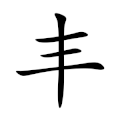丰
Hello, you have come here looking for the meaning of the word 丰. In DICTIOUS you will not only get to know all the dictionary meanings for the word 丰, but we will also tell you about its etymology, its characteristics and you will know how to say 丰 in singular and plural. Everything you need to know about the word 丰 you have here. The definition of the word 丰 will help you to be more precise and correct when speaking or writing your texts. Knowing the definition of丰, as well as those of other words, enriches your vocabulary and provides you with more and better linguistic resources.
| ||||||||
Translingual
| Stroke order | |||
|---|---|---|---|

| |||
| Traditional | 豐 |
|---|---|
| Shinjitai | 豊 |
| Simplified | 丰 |
Han character
丰 (Kangxi radical 2, 丨+3, 4 strokes, cangjie input 手十 (QJ), four-corner 50000, composition ⿻三丨(GJKV) or ⿻⿱㇒二丨(HT))
Derived characters
References
- Kangxi Dictionary: page 79, character 8
- Dai Kanwa Jiten: character 76
- Dae Jaweon: page 161, character 3
- Hanyu Da Zidian (first edition): volume 1, page 28, character 7
- Unihan data for U+4E30
Chinese
Glyph origin
| Historical forms of the character 丰 | |||
|---|---|---|---|
| Shang | Western Zhou | Shuowen Jiezi (compiled in Han) | Liushutong (compiled in Ming) |
| Oracle bone script | Bronze inscriptions | Small seal script | Transcribed ancient scripts |

|

|

|

|
|
References:
Mostly from Richard Sears' Chinese Etymology site (authorisation),
| |||
| Old Chinese | |
|---|---|
| 邦 | *proːŋ |
| 梆 | *proːŋ |
| 垹 | *proːŋ |
| 肨 | *pʰroːŋs, *pʰroːŋs |
| 蚌 | *broːŋʔ, *breːŋʔ |
| 玤 | *broːŋʔ |
| 棒 | *broːŋʔ |
| 蜯 | *broːŋʔ |
| 琫 | *poːŋʔ |
| 菶 | *poːŋʔ, *boːŋʔ |
| 俸 | *poːŋʔ, *boŋs |
| 髼 | *boːŋ |
| 蜂 | *boːŋ, *pʰoŋ |
| 韸 | *boːŋ |
| 蓬 | *boːŋ |
| 篷 | *boːŋ |
| 唪 | *boːŋʔ, *boŋʔ |
| 埲 | *boːŋʔ |
| 丰 | *pʰoŋ |
| 妦 | *pʰoŋ |
| 仹 | *pʰoŋ |
| 峯 | *pʰoŋ |
| 峰 | *pʰoŋ |
| 鋒 | *pʰoŋ |
| 烽 | *pʰoŋ |
| 蠭 | *pʰoŋ |
| 桻 | *pʰoŋ |
| 莑 | *pʰoŋ |
| 夆 | *pʰoŋ, *boŋ, *ɡaːds |
| 捧 | *pʰoŋʔ |
| 逢 | *boŋ |
| 縫 | *boŋ, *boŋs |
| 漨 | *boŋ |
| 捀 | *boŋ, *boŋs |
| 奉 | *boŋʔ |
Pictogram (象形) of a luxuriant plant growing on the ground (土), which is unrecognizable in the modern version since the bottom stroke is missing. See the top component of 豐 and 奉.
The original version is 𡴀, which however is unrelated to 㞷 (匩 (> 匡). Similar to 𤯓 > 生. Unrelated to 㓞 since it represents something carved/engraved, 丯.
Etymology 1
Simplified from 豐.
| For pronunciation and definitions of 丰 – see 豐 (“luxuriant; lush; abundant; bountiful; plenty; etc.”). (This character is the simplified and variant traditional form of 豐). |
Notes:
|
Etymology 2
| trad. | 丰 | |
|---|---|---|
| simp. # | 丰 | |
| alternative forms | 𡴀 䒠 | |
Pronunciation
- Mandarin
- (Standard Chinese)+
- Hanyu Pinyin: fēng
- Zhuyin: ㄈㄥ
- Tongyong Pinyin: fong
- Wade–Giles: fêng1
- Yale: fēng
- Gwoyeu Romatzyh: feng
- Palladius: фэн (fɛn)
- Sinological IPA (key): /fɤŋ⁵⁵/
- (Standard Chinese)+
- Cantonese
- (Standard Cantonese, Guangzhou–Hong Kong)
- Jyutping: fung1
- Yale: fūng
- Cantonese Pinyin: fung1
- Guangdong Romanization: fung1
- Sinological IPA (key): /fʊŋ⁵⁵/
- (Standard Cantonese, Guangzhou–Hong Kong)
- Middle Chinese: phjowng
- Old Chinese
- (Zhengzhang): /*pʰoŋ/
Definitions
丰
- having a lush growth of plants
- appearance
Compounds
Etymology 3
| For pronunciation and definitions of 丰 – see 丯. (This character is a variant form of 丯). |
References
Japanese
Kanji
丰
Readings
- Go-on: ふ (fu)、ぶ (bu)
- Kan-on: ほう (hō)、ふう (fū)
- Kan’yō-on: ぼう (bō)
- Kun: みめよい (mimeyoi, 丰い)、しげる (shigeru, 丰る)
Compounds
Korean
Hanja
丰 (eumhun 예쁠 봉 (yeppeul bong))
- This term needs a translation to English. Please help out and add a translation, then remove the text
{{rfdef}}.
References
Vietnamese
Han character
- This term needs a translation to English. Please help out and add a translation, then remove the text
{{rfdef}}.



